Old meets new in this view of Hongkou rooftops sharing the sky with the top of the Shanghai World Financial Center, built across the Huang Pu River in Pudong, which used to be mostly farmland twenty years ago and is now Shanghai’s Wall Street.
I thought this picture would be quite appropriate to show you first of all the photos I took on my trip to Shanghai because it aptly sums up the state of the city: New overtakes old at rapid speed; more than once my friend and I couldn’t proceed in our sightseeing as planned because a road or a complex that was still on our maps had been replaced by a gaping construction site.
I also thought that in honor of the current holiday of Passover, I might start my “reports” from Shanghai with a little essay on the former Jewish area. I wanted to post this earlier, but alas, I was too wrapped up in getting ready for Passover last week, too wiped out by the jet lag after returning home, and I’ve been too busy cooking ever since.
The rooftop picture was taken from Huoshan Park (Wayside Park), a tiny park on Huoshan Road, where the Jewish refugees used to gather in the 1930s and 1940s.
These days, a memorial plaque reminds visitors, in Chinese, English and Hebrew, of the former “designated area for stateless refugees.” Calling the area a former Jewish ghetto is actually a misnomer, since the Chinese and later the Japanese, who occupied this area, did not differentiate between Jews and other refugees (such as White Russians who fled their homeland after the Bolshevik Revolution in 1917). Rather, having been thrown out of their home countries, Jews were classified as stateless, and had to live in this designated area in Hongkou, the more working class neighborhood of the International Settlement, north of the fashionable Bund waterfront, and north of Suzhou Creek.
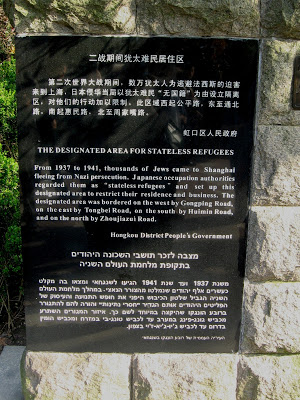
Erected in 1993 in honor of the visit of Israeli Prime Minister Yitzhak Rabin, this plaque reminds visitors that Wayside Park used to be a major gathering point for the Jews who fled Nazi persecution in Europe and found a safe haven in Shanghai. In the late 1930s, Shanghai was the only place not requiring a visa for entry. Jews, however, still had to obtain travel visas to make it out of their respective countries, and diplomates like He Fengshan, Chinese Consul General in Vienna from 1938 to 1940, helped with transit visas. It is said that about 30,000 Jewish refugees, mainly from Austria, Germany, Czechoslovakia and Hungary lived in this area that was already crowded when they came.
Just next to the memorial stone a typical park scene: old guys congregate to chat (I hardly ever saw children), and a bird cage hangs in a tree.
In Shanghai, birds are taken “for a walk,” if you will, just like other pets. Like this guy, people hang their bird cages in the park, often covered by the same blue cloth (where do all those blue cloths come from?). The parks are filled with chirping.
Speaking of Vienna, this street just opposite Wayside Park, Zhoushan Road, used to be called “Little Vienna” in the 1930s and 40s as it featured many cafés and stores selling European goods.
This building, also facing Wayside Park, is the former site of the American Joint Distribution Committee (JDC) from where many relief efforts to help Shanghai’s refugees were organized.
Typical Chinese street scene – as we were walking about, a man killed a fish on the pavement in front of Wayside Park. Life in its basic details is very much displayed and lived on the streets. Laundry is hung out to dry (I have a whole photo essay coming up on that!), sinks and dishes are set out for washing, games are played, and – fish are killed.
Like the former JDC building, many of the buildings in Zhoushan Road were built during the 1920s in Queen Anne style architecture, featuring contrasting red and black brickwork, Roman arches and Dutch gables.
59 Zhoushan Road: A plaque commemorates U.S. Secretary of the Treasurey Michael Blumenthal’s former home, and pots are waiting to be scrubbed.
Between the Queen Anne houses, an entry way leads to what we would call tenement housing beyond; and as always there’s space for a little shop.
Here, the tenement housing where most of the refugees lived. One “apartment” could be just a room of what looks like 10 by 10 feet. This passage way is about 4 feet wide. After the Jewish refugees left after the end of the World War II (foreigners, especially “capitalist” ones, were not welcome in the People’s Republic of China), Chinese people fleeing Mao’s forces crowded in here as they had been all through the 1930s. Shanghai was the last bastion of nationalist leader Chiang Kai-check.
Another Zhoushan Road street scene – a bunch of guys play a board game and are none too amused at our attention.
Zhoushan Road leads, once you turn left on Changyang Road, to the restored Ohel Moishe Synagogue. Founded in 1907, the synagogue moved to this site in 1927, and closed as a synagogue in 1949. No original Jewish artifacts remain, but the building was reconstructed and opened in 2008 to house the Shanghai Jewish Refugees Museum. Rightfully, the museum emphasizes Shanghai’s function as a safe haven and relates many personal stories of Jews who lived in this area. It also tells the story of what became of them once they moved on to places like Israel, Australia or the U.S., but sadly, it does not address why they had to leave yet again.
View of the Ohel Moishe Synagogue from the courtyard. It was built by putting two traditional Chinese townhomes together.
Pots with plants enliven the street scene outside the synagogue. We were fortunate enough to see the musical play
North Bank Suzhou Creek about the Jewish Shanghai refugees’ experience performed at the synagogue that evening. The play was rather endearing, and certainly captured my attention, but what as a biligual person myself, I really appreciated a play being performed in more than one language, in this case English, Mandarin, Yiddish and Hebrew. Lead actress
Emilie Ohana was most impressive in also being able to sing and play the violin rather well.
For those interested in learning more about Shanghai’s Jewish refugees, I recommend the 2002 documentary movie
Shanghai Ghetto.
So much for my first report of my trip to Shanghai. I hope you enjoyed it as more is to come!
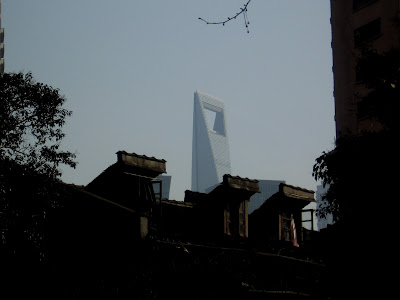



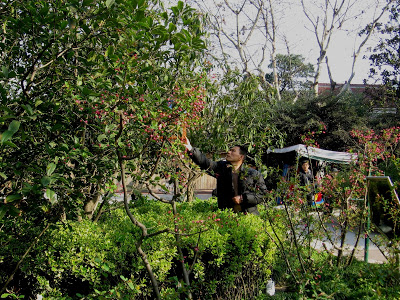
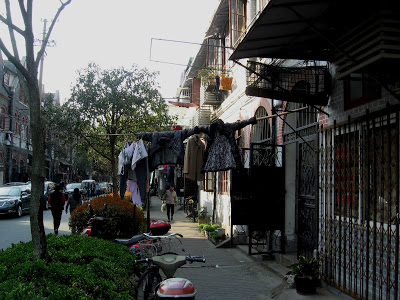
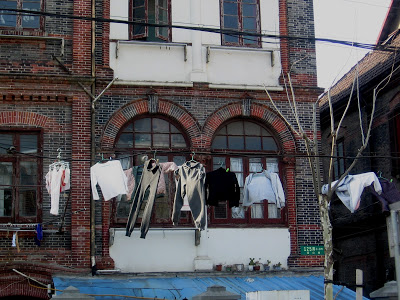
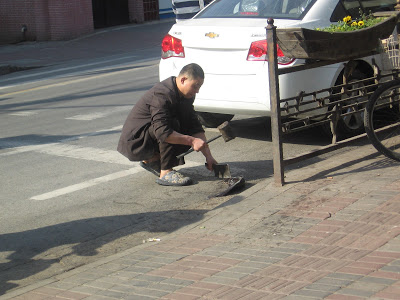


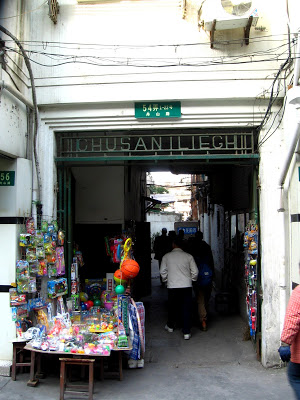
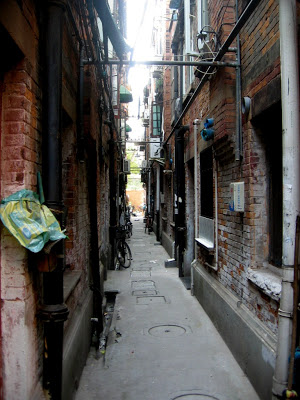
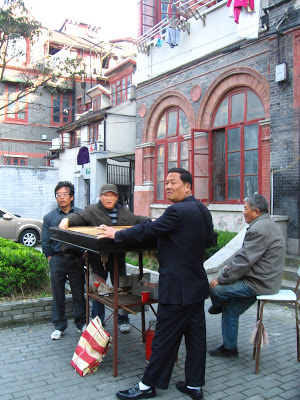



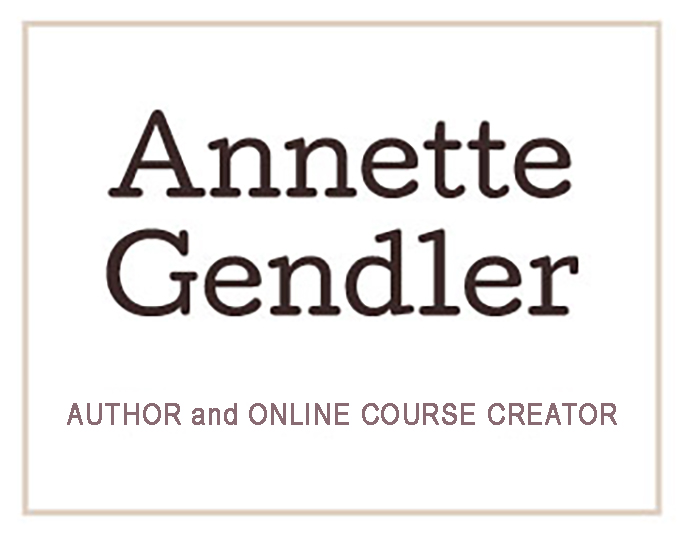
I enjoyed this collection. Thanks for sharing your photos of Shanghai. I love to see the culture in lands far away, even if only in a photo display.
Awesome!
So great to hear about your trip and see the photos. I know that you had the best tour guide ever! My book club read a great book about the Jewish refugees in Shanghai, but I cannot remember the title.
Diane – glad you liked this, more on Shanghai is to come!
Nancy – if you could dig up the title of the book you read, that would be great. I've been looking for a good read on this, but there are so many it's hard to choose. I still have Safe Haven on my to-read pile.
I am impressed, Annette! I learned something new from your post.. miho
Annette, what a fascinating post great information about a country that I know little about. thanks